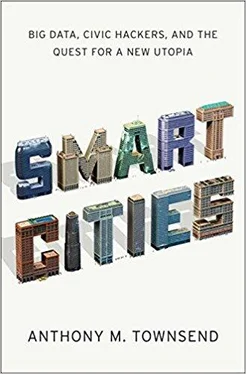Back in the world of electric power, you can forget about tracking electricity, much less directing it. To be fair, physics has stacked the deck against the power grid. Big flows of electricity can’t be chopped up and piped about the way digital bits can. Digital telecommunications networks use temporary containers called buffers to manage congestion at choke points. But keeping the power grid running smoothly is more of a balancing act than a job of directing traffic. Storage for electrical grids is much more expensive and problematic—instead of RAM chips, utilities must install massive flywheels, batteries, and capacitors to throttle the flow of power. Adding to the challenge is a lack of instrumentation. Unlike digital telecommunications networks, which by design are fitted with all kinds of flow sensors, the power grid is dumb. In Arbon, the Swiss town that Siemens has chosen as a guinea pig for its smart grid technology, the power company’s director readily admits that “even today, neither consumers nor suppliers know exactly when electricity is flowing through power lines, or how much of it is flowing.”
What’s perhaps more shocking is the age of the power grid, and how much of it is undocumented. Utility companies don’t know exactly where a lot of the infrastructure is. After the September 11 attacks in New York, I often rambled through the streets of Lower Manhattan late at night. Peering down into excavation pits, I watched as crews from Con Edison scratched their heads in bewilderment, struggling to untangle a century’s worth of cables unearthed in some subterranean vault. This is an extreme case, but most of the North American power grid dates from the 1960s. According to the head of the International Brotherhood of Electrical Workers, the electricians’ union, the average age of transformers (electrical devices that change the voltage of flowing current) in service in 2007 was forty years, which also happens to be their useful working lifetime.42 As the editor of trade rag EnergyBiz put it, “We are talking about equipment deployed before a man walked on the Moon, before cell phones and the Internet, when Frank Sinatra was in his prime.”
Siemens took a few more years than IBM or Cisco to refocus its ambitions on smart cities, in part because it’s a much larger company. Big ships are harder to turn. But in 2011 it made a massive shift by reorganizing more than 85,000 employees into a new Infrastructure & Cities division. Building smart cities is in fact a return to the company’s roots. Unlike GE, which was founded as an electricity company, Siemens actually got its start building communications networks. The first Siemens company, Telegraphen-Bauanstalt von Siemens & Halske, strung Germany’s first inter-city telegraph line between Berlin and Frankfurt in 1848.44 Since then, the firm has long dominated infrastructure markets that depend on electricity—not just power grids but also electric trains, an industry it leads to this day.
While Siemens still builds smart systems for telecommunications and transportation, the smart grid plays a special role in its vision for cities because, writes Jeff St. John on the GigaOM blog, it’s “one of the few corporations out there that can lay claim to almost every share of the world’s current grid infrastructure, building everything from gas and wind turbines to high-voltage transmission cables to sensors and controls that monitor and manage the delivery of power to homes and businesses.”45 Targeting nearly $8.5 billion (€6 billion) in annual smart grid business by 2014, CEO Peter Loscher boasted, “We’re on the threshold of a new electric age.”
As consumers, we think of the smart grid mostly through our growing experience with smart meters. Smart meters are to your old electric meter what a smartphone is to your grandmothers Bakelite 1950s rotary phone. It’s a souped-up, networked upgrade that constantly reports back to the electric company a stream of data about your power consumption, including when it detects blackouts and brownouts. The more advanced models can manage power-hungry appliances in your home. In-Stat, a market research firm, projects that by 2016 fully three-quarters of American electric meters will have been converted to smart meters.47 While these are the most visible endpoints of the emerging new grid, Siemens actually sold off its smart-meter business a decade ago. Its true ambition is to become a Cisco for electricity, providing the brains inside the smart grid, the software and switches that manage the behind-the-scenes balancing act that keeps the juice flowing.
The power grid shell game isn’t only about keeping the lights on, but doing it cost-effectively while letting loose as few emissions as possible. What makes this process hard is the erratic demand for electricity, particularly in cities. Electric utilities deal with irregular ebb and flow by building two different sets of power plants. Base-load plants serve the minimum demand for electricity that stays constant year-round. These highly efficient plants can be run more or less continuously at nearfull capacity. But because demand for electricity in a place like New York can spike as much as 40 percent on the hottest summer afternoons, utilities also build “peaking” plants that can be quickly brought online as needed. While peaking plants can also be highly efficient—most are natural-gas-powered turbines—they are far more costly per unit of power to build and run. If only the peaks could be evened out, fewer peaking plants would be needed and utilities could focus more on ruthlessly fine- tuning base load plants to be as lean and clean as possible.
Smart grids offer two tricks to even out the peaks: load shifting and load shedding.
Load shifting, the gentler of the two, tries to spread demand for power away from peak periods of demand through price incentives. In their simplest form, smart meters allow businesses and consumers to see the true cost of generating electricity during periods of high demand. As they fire up those costly peaking plants, utilities simply pass the higher generating cost along to consumers. Dynamic pricing can dramatically reduce swings in demand for power and increase overall generating efficiency, but load shifting can also be automated and proactive. Smart meters that communicate directly with smart appliances might automatically reschedule a load of wash for later in the day when demand and prices are likely to fall.
Even the most sophisticated load-shifting scheme will one day meet its limit. That’s when utilities wield their trump card—load shedding—a kind of targeted blackout. Traditionally, load shedding was a manual process. Utilities would cut deals with large users of electricity like factories and universities to shut down power during peaking crises in return for a discount on their regular rates. Smart meters will allow these miniblackouts to be replaced by sophisticated surgical drawdowns on sacrificial facilities and equipment. A university might agree to have its dormitories or office lighting shut off while service to sensitive laboratory instruments, for instance, is maintained. A factory could shut down a production line in stages to reduce the need to discard unfinished products damaged by idling.
Without smart controls like these, the grid’s problems will worsen rapidly. Even as demand surges, building new power plants only gets harder as NIMBY-led resistance to plant construction spreads in many countries. The wiggle room that once existed in the form of reserve generating capacity is fast disappearing, raising the possibility of regular blackouts in the future. During the 1990s, demand for electricity grew by 35 percent in the United States, but generating capacity increased by only 18 percent.
According to Siemens, smart grids will help utility engineers sleep at night, since load shedding and load shifting could reduce national electricity needs by up to 10 percent. 5° Environmentalists will cheer because improved demand management removes a key obstacle to greater reliance on renewable generating sources, which are notoriously unreliable base capacity—the sun doesn’t always shine and the wind doesn’t always blow. Even hydropower generated at dams depends on reliable seasonal rains to fill up rivers. Greater ability to reduce demand when the supply of green power falters will reduce the need for fossil-fuel powered backup plants.
Читать дальше












